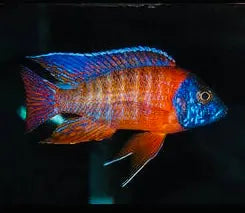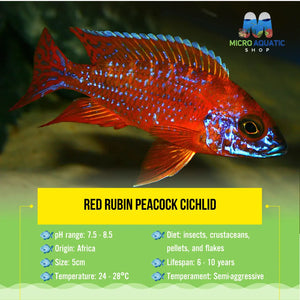Red Rubin Peacock Cichlid 5cm
Order today - receive it in as little as 3-5 days.
Return within 30 days of purchase. Duties & taxes are non-refundable.
Guarantee Safe Checkout

Red Rubin Peacock Cichlid 5cm
Peacock Cichlid (Red Ruby) - Vibrant Freshwater Fish for Aquariums
In the world of tropical fish, the Peacock Cichlid, or Red Ruby, is a standout. These fish come from Africa's warm waters and have stunning colours. They are a favourite among those who keep freshwater aquariums in Australia. The Peacock Cichlid's look is amazing, with a body that shows off reds, blues, and greens. Their colours and movements are captivating. They are also lively and fun to watch, making them great for aquariums.
The Peacock Cichlid's look is amazing, with a body that shows off reds, blues, and greens. Their colours and movements are captivating. They are also lively and fun to watch, making them great for aquariums.
It's important to know how to care for these fish. With the right care, they can be the highlight of any aquarium in Australia.
Key Takeaways:
- The Peacock Cichlid, also known as the Red Ruby, is a vibrant and captivating freshwater fish that is popular among aquarium enthusiasts in Australia.
- These fish are renowned for their striking colours, which range from brilliant reds and blues to shimmering greens, creating a mesmerising display in any aquarium.
- Proper care and maintenance are essential for the Peacock Cichlid to thrive, including providing the right aquarium environment and diet.
- With their engaging personalities and stunning appearance, Peacock Cichlids have become a highly sought-after addition to many Australian freshwater aquariums.
- Understanding the unique requirements of the Peacock Cichlid is crucial for ensuring their long-term health and happiness in captivity.
Introduction to Peacock Cichlid, Red Ruby
Discover the enchanting world of the Peacock Cichlid, also known as the Red Ruby. This vibrant freshwater fish has won the hearts of many aquarium lovers in Australia. They come from the clear waters of Lake Malawi in Africa, known for their bright colours and elegant movements.
Natural Habitat and Origins
Peacock Cichlids, including the Red Ruby, are found in the African Great Lakes, especially Lake Malawi. These lakes are famous for their wide variety of cichlid species. Each species has adapted to the unique conditions of their environment. The Red Ruby loves the warm, well-oxygenated waters of Lake Malawi, where it lives among many other colourful cichlids.
Physical Characteristics
The Peacock Cichlid's most striking feature is its vibrant red colour, ranging from deep crimson to brilliant scarlet. This colour is especially vibrant in the Red Ruby variant, making it a standout in any aquarium. They also have compact, streamlined bodies and graceful fins, allowing them to move easily through the water.
Significance in the Aquarium Trade
Peacock Cichlids, including the Red Ruby, are highly sought after in the aquarium trade. Their stunning appearance and ability to thrive in captivity make them favourites among hobbyists. They are known for their vibrant colours and interesting behaviours, making them a staple in cichlid care and a beloved pet in many Australian homes.
Setting Up the Perfect Aquarium Environment
Keeping Peacock Cichlids, also known as Red Rubies, happy in our freshwater aquariums is key. We must think about tank size, water quality, substrate, and décor. This ensures our vibrant fish can thrive.
Peacock Cichlids need lots of space. A tank of at least 55 gallons (208 litres) is recommended. They prefer slightly alkaline water, with a pH of 7.5 to 8.5 and a temperature of 24°C to 28°C.
For substrate, a fine gravel or sand mix is best. Peacock Cichlids love to burrow and sift. Add lots of rock formations, caves, and hiding spots. This mimics their natural habitat and makes them feel secure.
- Tank size: Minimum 55 gallons (208 litres)
- Water pH: 7.5 to 8.5
- Water temperature: 24°C to 28°C
- Substrate: Fine gravel or sand
- Décor: Rock formations, caves, and hiding spots
Finally, make sure your aquarium has a strong filtration system and good lighting. This keeps the water clean and simulates natural daylight. By setting up the perfect environment, our Peacock Cichlids will thrive and show off their stunning colours in our homes.
|
Aquarium Parameter |
Recommended Range |
|
Tank Size |
Minimum 55 gallons (208 litres) |
|
Water pH |
7.5 to 8.5 |
|
Water Temperature |
24°C to 28°C |
|
Substrate |
Fine gravel or sand |
|
Décor |
Rock formations, caves, and hiding spots |
Feeding and Nutrition Requirements
Keeping our Peacock Cichlids healthy and colourful is all about their diet. As aquarium experts, we know a balanced diet is key for these tropical fish.
Recommended Diet Types
Peacock Cichlids love to eat a mix of plants and proteins. They do well on cichlid-specific flakes or pellets and live foods like brine shrimp and bloodworms. This variety keeps them healthy and colourful.
Feeding Schedule and Portions
- Feed your Peacock Cichlids 2-3 times a day, just enough for them to eat in a few minutes.
- Change the amount of food based on how many fish you have and how hungry they are. Make sure a bit of food is left over.
- Don't overfeed, as it can harm the water quality and your fish's health.
Special Dietary Considerations
To keep your Peacock Cichlids looking their best, add colour-enhancing foods to their diet. Try spirulina, garlic, and foods full of carotenoids. Also, keep the water clean and well-maintained.
"A well-balanced diet is the foundation for the health and vibrant colouration of our Peacock Cichlids."
By sticking to these feeding tips and giving them a varied, nutritious diet, your Peacock Cichlids will flourish. They'll keep your aquarium a stunning sight to behold.
Breeding and Reproduction Guidelines
Keeping breeding cichlids is rewarding for tropical fish lovers. Peacock Cichlids, or Red Rubies, need special care for successful breeding. Knowing their breeding process is key for aquarium maintenance. To start breeding, create a special tank. It should have the right water and decorations that look like their natural home. Add rocks and caves for hiding, which helps with courtship and spawning.
To start breeding, create a special tank. It should have the right water and decorations that look like their natural home. Add rocks and caves for hiding, which helps with courtship and spawning.
- Choose a breeding pair by watching their colours and how they interact. Mature Peacock Cichlids show bright colours and play a lot.
- The breeding tank needs soft water, a bit acidic pH, and a warm temperature of 25-28°C. These conditions help them feel like it's breeding time.
- Give the breeding pair food full of protein and vitamins. Live or frozen foods like brine shrimp and bloodworms are great.
After the female lays eggs, the male will fertilise them. The parents will look after the fry until they can fend for themselves.
By following these steps and creating the right environment, you can breed cichlids successfully. Watching the whole life cycle in your tropical fish aquarium is very rewarding.
Health Management and Disease Prevention
Keeping our Peacock Cichlid, or Red Ruby, healthy is crucial for their well-being in our freshwater aquarium. We'll look at common health issues they might face. We'll also cover prevention and treatment, and why keeping water quality right is key.
Common Health Concerns
Peacock Cichlids can get sick like many fish. They might get fin and skin diseases, like ich (white spot disease) and flukes. They can also catch bacterial and fungal infections. If we don't treat these problems, they can get worse.
Prevention and Treatment
To keep our Peacock Cichlid healthy, we need to act early. Setting up a good quarantine for new fish helps stop diseases. We should also check our fish often and watch for any signs of illness. If we see a problem, we need to act fast and get help from experts.
Maintaining Water Quality
- Regular water changes are vital for a healthy aquarium.
- We must keep an eye on water parameters like pH, temperature, and ammonia levels.
- Good cichlid care and aquarium maintenance help prevent diseases and keep our fish happy.
By tackling health issues early, using prevention, and keeping water quality high, we can make sure our Peacock Cichlids are happy and healthy. They'll show off their bright colours in our freshwater aquarium.
Conclusion
Caring for peacock cichlids, or "red ruby," in a home aquarium is rewarding. These tropical fish add colour and personality to any tank. With the right care, they can thrive in our homes. For those interested in aquariums, peacock cichlids are a great choice. They bring beauty and interesting behaviour to any tank. Micro Aquatic Shop is a great place to find these fish and get advice.
For those interested in aquariums, peacock cichlids are a great choice. They bring beauty and interesting behaviour to any tank. Micro Aquatic Shop is a great place to find these fish and get advice.
Exploring the world of peacock cichlids can be very rewarding. It lets us create a thriving aquarium and enjoy the beauty of these fish. We hope this inspires you to start your own peacock cichlid journey.
FAQ
What makes the Peacock Cichlid (Red Ruby) a popular choice for freshwater aquariums?
The Peacock Cichlid (Red Ruby) is a stunning addition to any freshwater aquarium. Its vibrant red colouration and unique characteristics make it a highly sought-after fish among aquarium enthusiasts. These tropical beauties are known for their eye-catching appearance and lively personalities, making them a popular choice for both beginner and experienced aquarists.
What are the key physical traits of the Peacock Cichlid (Red Ruby)?
The Peacock Cichlid (Red Ruby) is known for its striking red colouration, which can range from deep crimson to a vibrant ruby hue. They have a distinctive body shape with a pronounced forehead and a long, flowing dorsal fin. These fish can grow up to 15 centimetres in length and have a lifespan of around 10 years with proper care.
How can we set up the perfect aquarium environment for Peacock Cichlids?
To create the ideal habitat for Peacock Cichlids, we recommend an aquarium with a minimum size of 100 litres. The tank should have a sandy or gravel substrate and be decorated with rocks, driftwood, and live plants to mimic their natural environment. Proper filtration and water parameters, such as a pH of 7.5-8.5 and a temperature range of 24-28°C, are crucial for their wellbeing.
What should we feed Peacock Cichlids to maintain their vibrant colours?
Peacock Cichlids are omnivores and require a balanced diet to maintain their stunning colouration. We suggest feeding them a variety of foods, including high-quality cichlid pellets, flakes, and frozen or live foods like brine shrimp, bloodworms, and daphnia. Supplementing their diet with spirulina or colour-enhancing additives can also help to intensify their red hues.
How can we successfully breed Peacock Cichlids in a home aquarium?
Breeding Peacock Cichlids requires careful preparation and attention to detail. Providing a dedicated breeding tank with rockwork or caves for the fish to spawn in, as well as a slightly acidic pH and cooler water temperature, can encourage courtship and spawning behaviours. Once the females have laid their eggs, the parents will need to be removed to prevent them from consuming the fry.
What are some common health issues to watch out for with Peacock Cichlids?
Peacock Cichlids are generally hardy fish, but they can be susceptible to common aquarium ailments like fin rot, ich, and bacterial infections. Maintaining excellent water quality, performing regular partial water changes, and quarantining new additions can help prevent the spread of diseases. Monitoring their behaviour and appearance for any signs of illness is also essential for their long-term wellbeing.
| Size |
1 pc |
|---|



